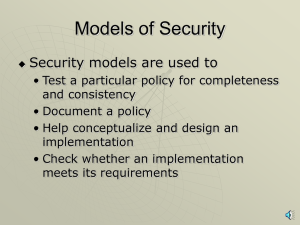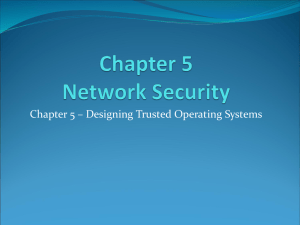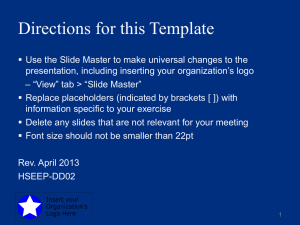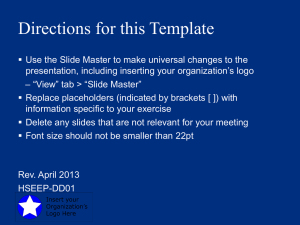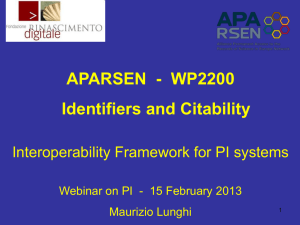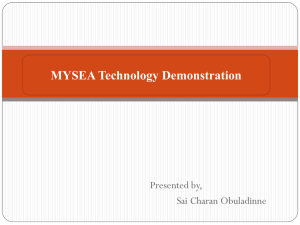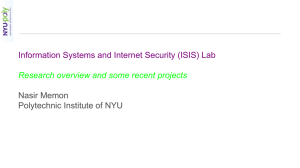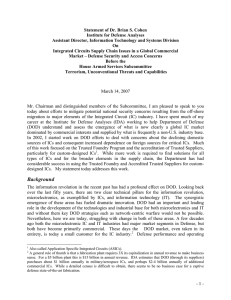Understanding and Mitigating Supply Chain Risks for Computing
advertisement
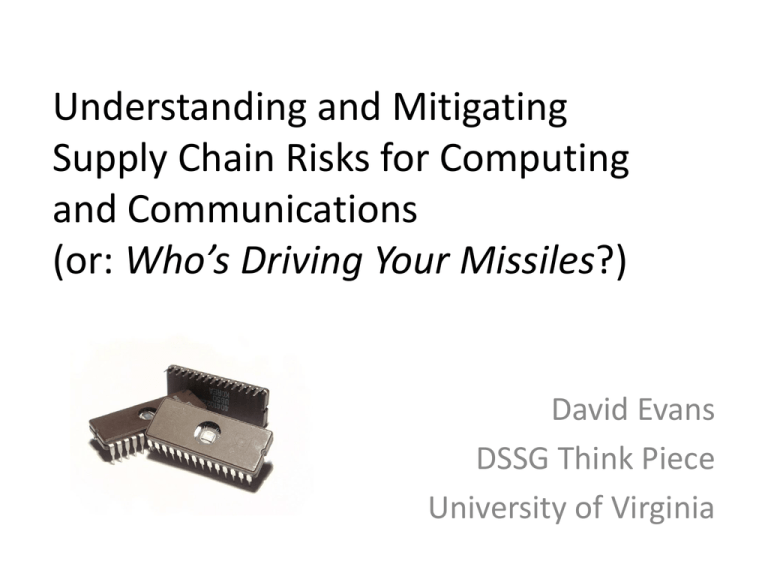
Understanding and Mitigating Supply Chain Risks for Computing and Communications (or: Who’s Driving Your Missiles?) David Evans DSSG Think Piece University of Virginia Federal prosecutors said the three contracted this year to provide integrated circuits to the U.S. Navy and other government agencies. They shipped such circuits to the Navy. They obtained the counterfeit circuits by importing them from China, the indictment alleges. Prosecutors said they imported more than 10,000 such chips. Defense Examples • Cold War Technology Trojans – Soviets tried to purchase pipeline software from Canadian company, request was denied – KGB then stole the software – but CIA learned of this and “updated” software – Trojan software created largest non-nuclear explosion ever, disrupted Soviet gas supply – Thomas Reed, “At the Abyss: An Insider’s History of the Cold War” • IBM Typewriters delivered to the US Embassy in Moscow • Israel / Syria Integrated Circuit Supply Chain (simplified) ASIC: Application-Specific Integrated Circuit Design Fabrication Assembly Deployment Modern fab: ~$2B Useful lifetime: ~3 years Mostly overseas 1964: USAF Minuteman II ICBM – 2-4000 ICs, 40% of cost is electronics 95% of US production of ICs are for DoD 2002: DoD is < 0.5% of world IC market (~$0.5B direct per year) [Brian Cohen, IDA] Verifying Ics? Design Fabrication Assembly Verifier DARPA: Trust in ICs Program Deployment Impossibility of Black Box Verification ~2100000 possible states, can design malicious logic that is triggered by one specific input White Box Verification: DARPA-Hard++ Typical ASIC: Millions of gates Only need a few hundred to hide malicious logic Known and trusted design: automated reverse engineering and inspection Trusted Foundry Program Design Fabrication Assembly Deployment Trusted Foundry NSA/DoD program created in 2003 ~12 accredited foundries: IBM, Northop Grumman, Sandia, etc. personnel with access to foundry are cleared same foundry can produce untrusted ICs Guidance: all systems of Mission Assurance Category I must use Trusted Foundry (“Systems handling information that is determined to be vital to the operational readiness or mission effectiveness”) Issues with Trusted Foundry Design Fabrication Assembly Deployment Trusted Foundry Design Tools Libraries Even trusted design relies on libraries, design software, etc. from possibly untrusted sources Issues with Trusted Foundry Design Fabrication Assembly Deployment Trusted Foundry How do you know chip is the one that came from the trusted foundry? Validating Trusted ICs Design Fabrication Assembly Deployment Trusted Foundry Record properties of trusted chip Secure Database interrogate chip Chip Verification: Physically Unclonable Functions (PUFs) Edward Suh (Cornell), Srinivas Devadas (MIT); Verayo 1 0 1 0 x0 0 1 0 1 Challenge bits x1 Challenge bits: which delay path to take ... ... Signals “race” through circuit: outputs 1 if top path is faster, 0 otherwise. Using PUFs to Validate Trusted IC Design Fabrication Assembly Deployment Trusted Foundry interrogate chip with set of random PUF challenges <chipID, <challenge1, response1> <challenge2, response2> ... <challengen, response>> Secure Database interrogate chip with known challenge and check response PUF Security Issues • How hard is it for an attacker to model the PUF? – More complex PUF designs – Cryptographic protections (one-way hash) on output • How hard is it for an attacker to tamper with the rest of the chip without effecting the PUF? – Integrate PUF into circuit (design complexity) • Deployment issues: when and how to validate Opportunity for continuous end-to-end validation from foundry to deployment. Alternate Direction: FPGAs Custom ASICs High Cost (application-specific) High Performance Fixed logic (not programmable) Field-Programmable Gate Arrays General-Purpose Processors Low Cost (mass market) Low Performance Fully programmable Secure FPGA Bitstream Encrypted and signed with Private Key Control Core Public Key Field-Programmable Logic Trusted Designer Private Key Generic, secure FPGA produced by Trusted Foundry Advantages of FPGAs • Mass produced FPGA – One Trusted FPGA design could support many applications – Performance gap is shrinking (close to ASICs) • Core is simple compared to General-Purpose Processor – Limit size, can verify small core • Custom logic can be protected – Removed from chip when vulnerable • Protect and verify bitstream cryptographically – Public key stored in FPGA core Using COTS Equipment Counterfeit Cisco Routers Operation “Cisco Raider”: $76M in fake Cisco routers Top Secret Two brothers entered guilty pleas on Tuesday for selling counterfeit “Cisco” products to federal agencies, the U.S. military and others…. Edman’s customers included the Marine Corps, Air Force, FBI, Federal Aviation Administration, Department of Energy, as well as defense contractors… Strategies for Using COTS • Limited interface – Network device to monitor untrusted device • But how do you trust the monitoring device? • Redundancy – Multiple devices from disjoint supply chains – Monitor that they behave “identically” • Avoid targeted attacks – Sales channel should not know it is going to DoD – What are the risks for embedding Trojan in design? • Software updates – Protected by digital signatures…but how are internal processes protected? Good News/Bad News? “It’s certainly possible for the world’s major espionage services to secretly plant vulnerabilities in our microprocessors, but the threat is overblown. Why would anyone go through the effort and take the risk, when there are thousands of vulnerabilities in our computers, networks and operating systems waiting to be discovered with only a few hours work?” Bruce Schneier (CTO of BT Counterpane) Summary • Trusting ICs is essential: all of our computing and communications depends on them • This is a hard problem: Sophisticated attacker can easily hide a Trojan in IC, cannot be detected by testing • Trusted Foundry: control the supply chain – Impossible to completely isolate – Need ways to verify end-to-end trust – Minimize costs and size of trusted components: generic trusted FPGA, trusted bitstream • COTS equipment – Avoid targeted attacks Thanks! IDA NSA Sandia LLNL Mike Adams, Brian Cohen, Katie Gliwa, Anil Joglekar, Lee Hirsch Denise Peake, Jeri Selinger Chuck Oien, Keith Vanderveen Ron Kane, Debbie May DSSG Mentors and Members
